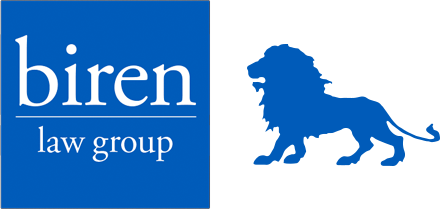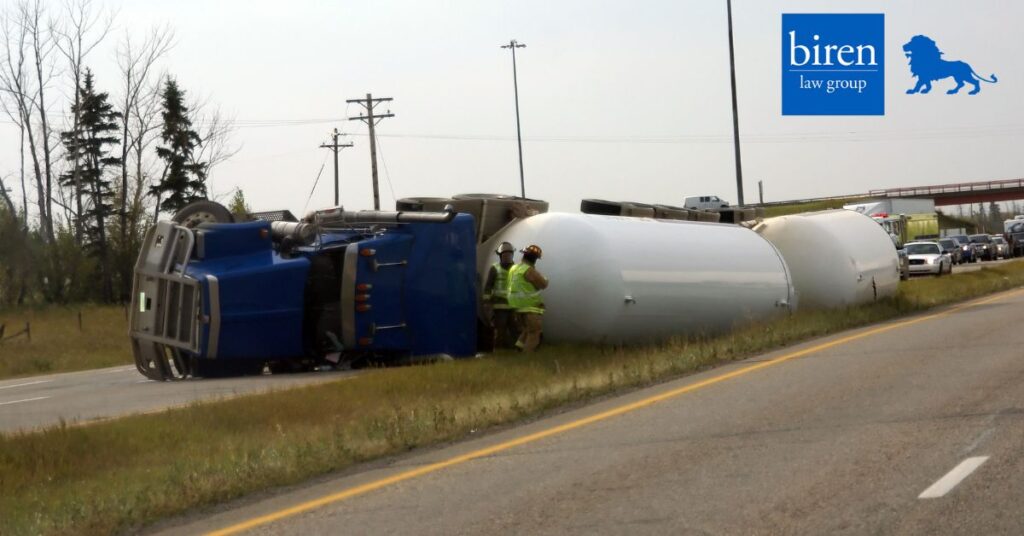Trucking accidents can have devastating consequences, causing severe injuries and property damage. Understanding the causes and liability associated with these accidents is crucial for both truck drivers and other motorists on the road.
At Biren Law Group, we are dedicated to helping our clients navigate through the complexities of trucking accident cases and seek the compensation they deserve. In this blog, we will delve into the intricacies of trucking accidents, shed light on their causes, and explore the legal aspects of liability.
Common Causes of Trucking Accidents:
- Driver Fatigue: Long hours on the road can lead to driver fatigue, impairing judgment and reaction times. Federal regulations limit the number of hours a truck driver can spend behind the wheel without a break, but violations are not uncommon.
- Speeding: Speeding is a significant factor in truck accidents. The size and weight of commercial trucks make it challenging to stop quickly, and high speeds increase the severity of collisions.
- Distracted Driving: Distractions, such as cellphone use, eating, or adjusting in-cab technology, divert a driver’s attention from the road. Distracted driving can lead to accidents with serious consequences.
- Improper Loading or Cargo Securement: Incorrectly loaded or unsecured cargo can cause a truck to become unstable or lead to cargo spillage, creating hazardous conditions on the road.
- Mechanical Failures: Malfunctions in a truck’s mechanical systems, such as brakes or tires, can contribute to accidents. Regular maintenance and inspections are essential to prevent these failures.
- Driving Under the Influence (DUI): Despite strict regulations, some truck drivers engage in driving under the influence of alcohol or drugs, significantly increasing the risk of accidents.
- Inadequate Training: Insufficient training for truck drivers can result in poor decision-making and inadequate handling of the vehicle, leading to accidents.
- Weather Conditions: Adverse weather conditions, such as rain, snow, or fog, can make driving hazardous. Truck drivers must adjust their driving to the prevailing weather conditions.
Determining Liability in Trucking Accidents:
- Driver Liability: Truck drivers are often held liable for accidents caused by factors such as fatigue, speeding, or distracted driving. Violations of federal regulations, such as exceeding hours-of-service limits, can strengthen a case against the driver.
- Employer Liability: Trucking companies can be held liable for accidents if they fail to ensure proper training, enforce safety regulations, or adequately maintain their fleet. Negligence in hiring practices, such as employing drivers with poor safety records, may also contribute to liability.
- Manufacturer Liability: If a truck’s mechanical failure is attributed to a design flaw or manufacturing defect, the truck’s manufacturer may be held liable for resulting accidents. This is known as product liability.
- Cargo Loading Liability: Companies responsible for loading and securing cargo are liable if improper loading leads to an accident. Ensuring proper cargo distribution and securement is vital for preventing accidents.
- Third-Party Liability: In some cases, liability may extend to third parties, such as maintenance contractors or shippers. If their actions contribute to an accident, they may share responsibility.
- Government Liability: Poorly maintained roads or inadequate signage may contribute to accidents. In such cases, government entities responsible for road maintenance may be held liable.
Investigating Trucking Accidents:
- Accident Reconstruction: Analyzing the accident scene, vehicle damage, and skid marks to reconstruct the sequence of events.
- Driver Records: Reviewing the truck driver’s logbook, employment history, and training records to assess compliance with regulations.
- Vehicle Inspections: Examining the truck’s maintenance and inspection records to identify any mechanical failures or issues.
- Electronic Data: Retrieving data from the truck’s electronic control module (ECM) or event data recorder (EDR) to understand the vehicle’s actions leading up to the accident.
- Witness Statements: Gathering statements from eyewitnesses and others involved in the accident to provide additional perspectives on the events.
Legal Recourse for Victims:
- Medical Expenses: Coverage for current and future medical treatment related to the accident.
- Lost Wages: Compensation for income lost due to injuries, including potential future earnings.
- Pain and Suffering: Damages for physical and emotional distress caused by the accident.
- Property Damage: Reimbursement for the repair or replacement of damaged property.
Biren Law Group Understands Truck Accidents
Trucking accidents can certainly be life-altering events, and understanding the causes and liability associated with them is crucial for victims seeking justice. By providing tangible tips and insights into the legal aspects of trucking accidents, we aim to empower our readers to make informed decisions and protect their rights.
If you or a loved one has been involved in a trucking accident, don’t hesitate to reach out to Biren Law Group. Our experienced attorneys are here to guide you through the legal process and fight for the compensation you deserve.
Call Biren Law Group today at (310) 774-0078 or contact us online.

